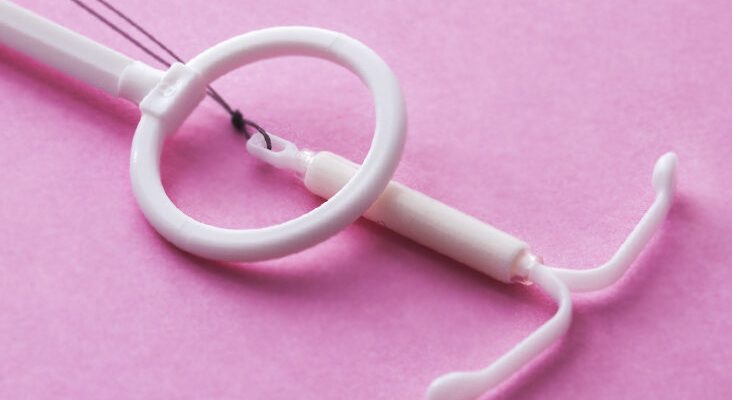Is The Copper IUD a Good Idea?
You might anticipate my answer here. It’s nope.
The copper IUD is not a good idea. In fact, for women who are already suffering from PMS, mood swings, and heavy periods, it’s a downright bad idea.
What is the copper IUD?
The copper IUD is a little T-shaped device about 1.25 inches in length. An OBGYN inserts the device into your uterus, where the copper acts as a spermicide to prevent pregnancy. It’s pretty effective, too. The copper IUD that is marketed under the brand name ParaGuard has a one year failure rate of a mere 0.8% (source).
Why do many women get IUDs?
While a great majority of women get IUDs to prevent pregnancy, others get IUDs as an attempt to “regulate hormones”. We know that this is a fallacy, as all hormonal birth controls shut off the body’s own production of both natural estrogen and natural progesterone. Hormonal birth control is effectively a (usually) temporary castration for women.
The first birth control pill was actually marketed as a way to “regulate hormones” since birth control was thought to be immoral at the time. My faith compels me to agree with this in theory, though I cannot throw stones as I have taken every conceivable form of birth control there is. Just keepin’ it real.
Now, for the women who go on birth control to regulate hormones, the problem is greater than they realize. Generally it’s high estrogen levels that drive most of the symptoms that make women aware of the fact that their hormones are indeed imbalanced. Weight gain, acne, low libido, PMS, mood swings, sore boobs, endometriosis, ovarian cysts, and sleep issues are often due to high estrogen and low progesterone.
Put a sister on the Pill or hormonal IUD, and all you’re doing is driving more estrogen into her poor body while at the same time, shutting down ovulation and with it, any hope of creating soothing, calming progesterone. After coming off the Pill (or perhaps even on it), her symptoms will get worse.
Pill = more toxic estrogen = more hormone imbalance.
Hormonal IUD = same thing.
But Jennifer! We’re talking about the copper IUD.
I know, I know. There are different issues with the copper IUD. But the same root cause remains.
It’s estrogen.
Estrogen and copper are like those two snotty girls in high school. They are always together, and they are always making trouble.
Copper and estrogen like to hang out together. The more copper one has in the body, however, the more estrogen tends to increase. And the higher estrogen is in the body, the more likely you are to store extra copper.
Copper also tends to deplete zinc, and zinc is needed for healthy periods and healthy immune function. Copper also depletes B6 and magnesium. This is why I recommend zinc, B6, and magnesium as my foundational supplements for Better Periods.
Copper also makes your body retain sodium and can lead to more bloating. No, thank you!
If you’re suffering from the symptoms listed above, you certainly don’t want any more estrogen in your body. Especially if you’re suffering from heavy flow- one average, menstrual flow increases 20-50% with the copper IUD (source).
Menstrual flow increase is the least of your worries when you’re copper toxic. There are a wide variety of symptoms women experience when their copper levels are high including exhaustion, adrenal issues, PMS, low libido, anxiety, hair loss, anemia, and yeast infections. Check out this comprehensive list of copper-toxic symptoms from coppertoxic.com.
Suffice it to say, these are all of the symptoms you’ll feel when you have “hormone imbalance”.
I see this clinically and the research also supports the copper-as-estrogen-driver theory.
A rat study showed that when a copper IUD was inserted, clear estrogen dominance took place- more estrogen was found in the system than progesterone, by far (source).
So, how can you know if you have too much copper?
I love using the Hair Tissue Mineral Analysis here. It shows copper toxicity in the body, but also hidden copper toxicity. As copper can be toxic in large amounts, the intelligently designed body squirrels it away in the soft tissue as a protective mechanism. As estrogen levels are brought down and minerals are rebalanced, sometimes copper will show up on HTMA retests as the body starts feeling safe enough to let it go.
Here’s a comparison of an HTMA from the same woman (me). A year ago, my copper levels looked low. But also notice how low my sodium and potassium levels were. Sodium and potassium levels that low reveal that my adrenal function was pretty suboptimal.
When I was able to raise those mineral levels back up to normal levels through diet, lifestyle, and mineral supplementation, my body started to excrete more copper.
It might appear that those copper levels are “normal”, but there are signs that my body is simply starting to mobilize the copper and that next time I test, levels will be higher before they will be lower.
My next step is to work on breaking down the calcium buildup in my body. When calcium levels are as high as they are in my soft tissue, thyroid hormone has a tough time doing its job and the metabolism starts to slow down (this is why women who are chronically stressed or suffer a major life trauma tend to put on 15 pounds overnight that they cannot get off- thyroid hormone can no longer regulate the metabolism as well as it once did). Notice that selenium is also low. This is another mineral that is very necessary for proper thyroid function. Needless to say, 2021 is The Year Of The Thyroid for this girl. I will be working on mineral rebalancing and thyroid receptor sensitivity using diet, lifestyle, and supplement interventions.
I can’t go back and undo the trauma of my baby sister getting killed by a drunk driver or the stress of mom-ming and wife-ing and working, but I can be gracious to myself and to others. I can work on getting plenty of sodium and plenty of potassium. I can get the fat-soluble vitamins I need to get that calcium back into my bones instead of my soft tissue. I can eat regular, nourishing meals and not push my body into overexercising. I can, in short, do all of the things I recommend for you, dear readers.
I run the HTMA on all of my JWN Intensive and also my Total Transformation clients. Book a consultation with me if that is something you are interested in.
Copper and Diet
Dietarily, if you’ve got a lot of copper, you should veer toward a meat-heavy omnivore diet. I’m so surprised, said no one who knows me.
Vegetarian foods are comparatively high in copper. Meat is high in zinc. Zinc and copper balance each other out, and recall that zinc is aa major player in my Better Periods supplement protocol.
These foods are high in copper:
- chocolate
potatoes
sweet potatoes
cashews
chickpeas
tofu
mushrooms
Interestingly, beef liver is also high in copper- the highest, in fact. Exercise caution with beef liver if you’re trying to stay away from too much copper.
But don’t go copper-free. Copper is still an essential mineral in the body. You need little bits. Copper helps energy production, iron metabolism, and creation of neurotransmitters. But just like everything else, it needs to be in balance. On average, women need about 1.1 mg of copper a day. It’s easy to get this in the diet.
Excreting it is more of a problem. If you don’t have a gallbladder, or if you have compromised or sluggish liver function, you won’t have the bile necessary to excrete that stored copper. If you are PMS-ing and also constipated, you’re probably a little copper toxic.
All that to say, the copper IUD is going to make your Periods Worse, and not Better. Think of your body 1 year from now, 5 years from now, 20 years from now. Hormone balance is essential for women to feel their best, and meddling with hormones via newer technologies like birth control and IUDs are not the wisest thing we have ever done for our women.
Learn the Fertility Awareness Method. Track your cervical fluid and body temperature. Figure out the 6 days each month that you are actually fertile, and simply abstain from sex for those days. If you’re like most women I work with, that excess estrogen is suppressing your libido anyway (I kid, I kid).
And if you’re on the IUD for hormone issues, dig a little deeper. Get to the root cause. Hormonal or copper birth control is not the answer necessarily. If you’re moody, bloated, and acne-prone, you don’t have a birth control deficiency. There is an underlying imbalance there, and we can use functional lab testing to help you figure out what that may be.
What do you think? Questions? Comments? Reach out to me at jennifer@jenniferwoodwardnutrition.com and let me know!
Love,
Jennifer





